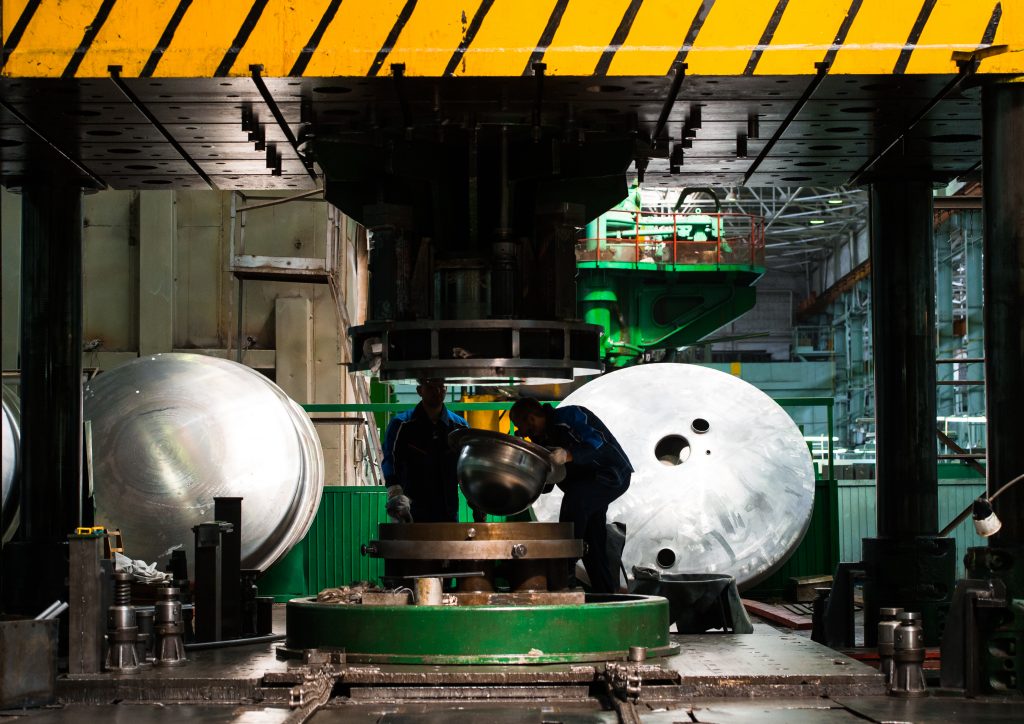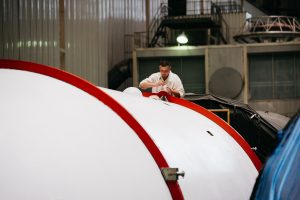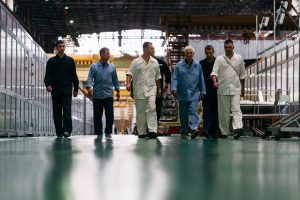PHOTO-REPORT FROM SRC PROGRESS: FINAL PHASE OF SOYUZ-2 LV PRODUCTION
Joint-Stock Company ‘Space Rocket Center Progress’ (SRC Progress) is one of the leading enterprises in the Russian space and rocket industry. To date, more than 1900 launch vehicles (LV) manufactured by SRC Progress, Samara, have been launched, and about 1000 spacecraft (SC) have been orbited.
On April 12, 1961, Yuri Gagarin became the first cosmonaut of the planet to leave the Earth’s atmosphere on the Vostok launch vehicle, the first and second stages of which were made at the SRC Progress. Based on the legendary R-7 (R7A) rocket, three-stage medium-class launch vehicles were developed: Vostok-2M, Voskhod, and the legendary Soyuz. Since 1961, all launches of the Russian manned spaceships have been carried out by launch vehicles produced in Samara.
In 1962-1991, the company participated in such large-scale space projects as the creation of the N1-L3 “lunar” system and Energia-Buran reusable space system, and gained tremendous design and production experience.
In the spring of 2019, SRC Progress launched production of the Soyuz-5 two-stage rocket. It will be able to orbit loads weighing up to 17 tons. Flight tests are scheduled for 2022.
The company was established in 1996 by the merger of the Central Specialized Design Bureau (TsSKB) and Samara’s Progress plant. To see the production of launch vehicles is a rare opportunity since the enterprise has a security system and one cannot shoot close-ups or panoramic views of the workshops. We have selected photos to show you how the famous space rockets are made.
Soyuz-2.1a and Soyuz-2.1b launch vehicles consist of three stages. The LV injects a satellite into its target orbit. The Soyuz-2 family launch vehicles use environmentally friendly propellant components (oxygen-kerosene) for flights. Each stage has its own engine.
Tanks to be integrated into a rocket are made of rectangular solid sheets of metal at the tank production workshop.
In the machine workshops, lathe and milling machine operators produce parts that will be used for the assembly of components and assemblies.
Parts are formed from sheet billets at the press sections.
Riveting of an LV structure is performed at the assembly and riveting workshop.
Riveting of an LV structure element with pneumatic stapler gun.
Manufacture of tank bottoms.
Smoothing of tank bottoms.
COMPONENTS USED FOR THE ASSEMBLY OF LV STAGES ARE BROUGHT TO THE FINAL ASSEMBLY WORKSHOP.
The stages are placed apart in the LV final assembly workshop, the floor space of which is larger than a soccer field. Final operations are carried out at the workshop’s control and test station prior to the LV shipment to cosmodromes. In the photograph, an employee works with a strap-on booster. The LV comprises four cone form strap-ons, which together constitute a first stage. Their operation makes the rocket lift off and fly for several dozens of kilometers and after 118 seconds of flight these boosters are jettisoned.
Technologic rings are installed for the stage transfer and operations with units at the final assembly workshop.
Transfer of a strap-on booster from the assembly area to the test area.
Mounting of strap-on booster cables.
Attachment of brackets in the intertank bay.
Installation of transportation ring on the second stage.
Transfer of the second stage.
Interstage frame.
LET’S REVIEW THE SOYUZ-2 THIRD STAGE PREPARATION PROCESS.
In the photograph, the employees work with the third stage structural elements. The third stage starts operating above the Earth’s atmosphere and continues to deliver a spacecraft to the target orbit, after which it separates and falls in the agreed drop zone.
Transfer of the third stage element in the assembly workshop.
Third stage with a protective transportation ring.
Engines for the first and second stages of Soyuz-2.1a and Soyuz-2.1b are produced by JSC Kuznetsov, Samara.
Elements to be removed before flight are intentionally painted in red so that workers do not forget to remove them before the LV launch.
The photograph shows third stage engine RD-0110 (for Soyuz-2.1a LV) produced by JSC Chemical Automatics Design Bureau (KBKhA).
Fairings for Soyuz-2 LVs are manufactured at the assembly and riveting workshop. In the photograph, an employee visually inspects a fairing half. Cone shape of the fairing helps the rocket to overcome the Earth’s atmosphere. Spacecraft to be injected into the required orbits are accommodated in the upper part of the rocket; this very part of the launch vehicle is covered by a fairing.
Finishing-coat is applied in the paint room after completion of all the LV tests.
In the photograph, an employee marks a fairing half shroud ring.
A manufactured launch vehicle then goes to the loading and packaging section. In the photograph, employees are loading the covered strap-on booster into the shipping container for rail transportation. LVs are transported to the following spaceports: Baikonur in Kazakhstan, Plesetsk in the Arkhangelsk Region, Vostochny in the Far East and Kourou in the French Guiana, South America.
At present, more than 15 000 people work in the company.




























